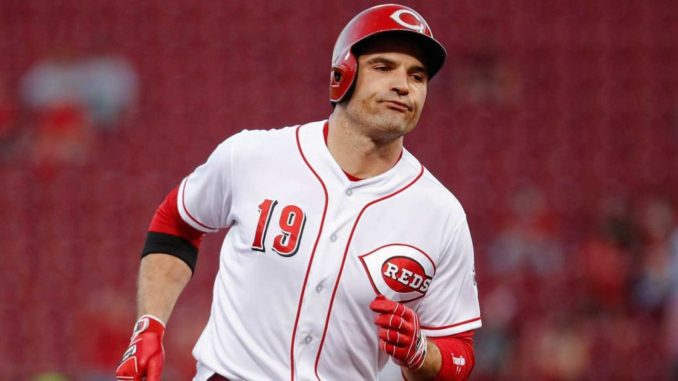
After making the playoffs in 2013, the organization returned most of the same team in 2014 and had a dispiriting collapse. The team publicly announced after the season that there would be a rebuild, but that it would be a quick, accelerated rebuild… more like a re-tooling actually… unlike the long rebuilds undertaken by other teams like the Houston Astros.
The team I’m talking about is of course the Cincinnati Reds. What, were you thinking this sounded like someone else?
Those early parallels with the Atlanta Braves don’t go very far however. After quickly ripping off the band-aid with painful trades of top performers like Jason Heyward, Justin Upton, Evan Gattis, and Craig Kimbrel in that first offseason the Braves started down a path of losing that eventually netted them a huge bounty of minor league talent. The second wave of that talent is now breaking into the major leagues, and the Braves are seeing the results in their win-loss record, and are at the top of the division as of this writing.
The Reds however resisted an immediate strip-down of their major league roster. Starting pitchers Mat Latos and Alfredo Simon were traded during the 2015 offseason, and impending free agents Johnny Cueto and Mike Leake were traded at the 2015 deadline. Reliever Aroldis Chapman and third baseman Todd Frazier however weren’t moved until the 2016 offseason. Outfielder Jay Bruce wasn’t moved until the 2016 trade deadline. For no apparent reason, the Reds elected not to trade shortstop Zack Cozart at all, and he left for the Angels this offseason as a free agent without the Reds getting any compensation at all.
Other than the Simon trade (which netted them a true star in third baseman Eugenio Suarez), the returns to the Reds in these trades have been less than impressive. Most of the major league assets de-valued the longer the Reds held on to them. It also hasn’t helped the team that formerly highly ranked prospects like Cody Reed, Robert Stephenson, Jesse Winker, and Jose Peraza haven’t made significant major league impact to date.
And so the Braves and Reds find themselves going in opposite directions. The Reds have already fired their manager, and are currently 23-43, last in the NL Central and 16 and a half games off the pace despite Joey Votto continuing to show at age 34 that he’s one of the best hitters in the game, Suarez cementing his place as one of the game’s best young infielders in the first year of a team-friendly 7-year contract extension, and second baseman Scooter Gennett having a career year. The rest of the line-up is largely anemic, and the starting pitching has been fairly atrocious to the point that the Reds picked up disgraced former Mets starter Matt Harvey and he provided an immediate upgrade.
So with all of that as background, let’s look at the Cincinnati Reds as potential trade partners with the Braves. What does this struggling team have that could be of interest to Atlanta and what would they want in return?
To start off with, I am limiting this to players that are currently on the Reds active roster or disabled list. I am assuming that the Reds will not be willing to part with their top prospects, and it seems unlikely the Braves would necessarily want to trade for them. Also, Joey Votto and Eugenio Suarez will be off-limits. Votto is a great player, but is owed $132 million over the next five seasons and does not have a position to play with the Braves. Likewise, as much as I think he would be a tremendous addition to the Braves, Suarez would be a player the Reds would want to build around, and trading him in the first year of a 7-year extension would send a chilling signal to other young players the Reds would potentially like to extend.
Scooter Gennett
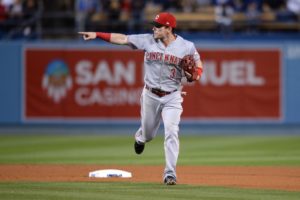
Gennett is the current NL batting leader and he currently carries a .340/.376/.556 batting line with 12 home runs. For that production, the Reds are paying him a more than reasonable $5.7 million, and he has one year of team control remaining for 2019 under the arbitration process. He’s a left-handed hitter.
Gennett has played only second base this season, but has had some experience at third base and the outfield. That said, Gennett rates as a below average defender at every position, but the worst he’s played was the 71 innings at third that he played last season. Gennett just had his 28th birthday last month, and he’s enjoying the best season of his career, though he was no slouch last season, hitting .295/.342/.531 with 27 home runs.
How he could fit: A guy with a .932 OPS would fit in anywhere, even if there was a defensive trade-off. My idea would be to play him at third base against right-handed pitchers and in left field (with Acuna moving to center and Inciarte to the bench) against left-handed pitchers.
The line-up would be trickier since having three left-handers in a row would not be ideal. I think I would have him lead-off, with Acuna hitting second, Freeman third, Markakis, fourth, and Albies fifth. In any case, he would be a line-up improvement wherever his batted. Next season he could slide into left field with Acuna moving to right.
What would it take? In dealing Gennett, the Reds are dealing from an area of relative strength organizationally. Suarez is already set in the infield, with Nick Senzel and the just-drafted Jonathan India likely to be up within the next 12 months. What the Reds need organizationally is pitching, which is just what the Braves have.
Looking a trades of similarly valued players at Gennett’s contract level with his amount of team control remaining, a fair trade may include a mid-level pitching prospect around the A+ level plus a pitcher at or near the majors.
Example: Max Fried and Tucker Davidson.
Jared Hughes
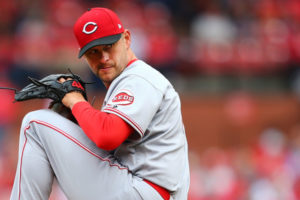
Jared Hughes is a 32-year-old 7-year major league veteran, mostly with the Pittsburgh Pirates, who signed a two-year, $4.5 million with the Reds this past offseason. He has a career 2.69 ERA, all in relief, and is having the best year of his career in 2018. He currently has a 1.02 ERA in 30 appearances. Somehow while playing his home games in the bandbox known as the Great American Ballpark, he has only allowed one home run this season. His 27% inherited runs scored is running fairly even with his career mark of 24%. In short, Hughes is exactly the kind of player a rebuilding team should be trading, a veteran on a short deal having the best season of his life.
How he could fit: While the Braves bullpen has been solid on the whole, it could certainly use more depth. The 8th-man in the bullpen has been a revolving door. Veteran Peter Moylan, brought in to be a right-handed batter specialist, is having trouble getting righties out and is giving up inherited runners in bunches. Hughes could permanently fill the 8th-man role. Alternatively, if the team feels Luiz Gohara is the man for that job, he could replace Moylan. Either way, the bullpen gets a capable veteran and an instant upgrade.
What would it take? Hughes has been of similar value as Joe Smith, who was conveniently traded by Toronto to Cleveland last season at the deadline. That trade cost Cleveland a mid-level starter and infielder. Assuming the Reds would want only pitching, an equitable trade may be a mid-level starter and a reliever.
Example: Lucas Sims and Thomas Burrows.
Raisel Iglesias
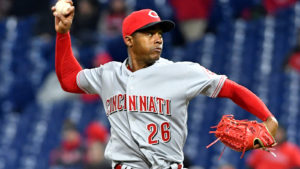
Raisel Iglasias has been the Reds closer since 2017, and over the last two years has been one of the best in the game at converting high-leverage plate appearances into outs. He has a 3.06 career ERA with a 10:3 strikeout-to-walk ratio. Since the start of 2017 he has held opponents to a .202/.277/.306 batting average and this year he has a 2.33 ERA in 27 innings pitched. A Cuban defector, Iglesias signed with the Reds as a 24-year-old to a 7-year, $27 million contract which will keep him under team control through the 2020 season.
It’s this amount of team control that may cause the Reds not to trade Iglesias. The Reds put such a high price on him in offseason trade talks that no other team really got beyond the exploratory stage. The Reds may slightly lower their demands now that the realities of a disastrous 2018 are coming into focus. The question then becomes, do the Reds think they’ll get back into contention before Iglesias’s contract is up?
How he could fit: If the Braves were to acquire Iglesias, he would immediately become the primary high-leverage reliever, and the Braves bullpen would immediately vault into the top five or six units in the National League.
What would it take: Woo-boy, this is going to hurt. The cost for quality relievers, either on the trade or free agent market, has steadily increased, even as other player roles have declined. The closest valued reliever to Iglesias to be moved recently with similar team control was Sean Doolittle, who was traded by the A’s to the Nationals last season. Based on that trade, I think it would cost the Braves two significant pitching prospects, plus a reliever at or near the majors.
Example: Bryse Wilson, Freddy Tarnok, and Evan Phillips.

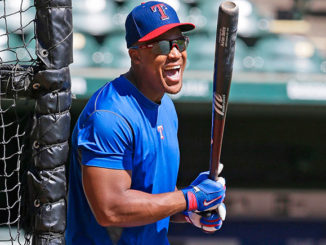

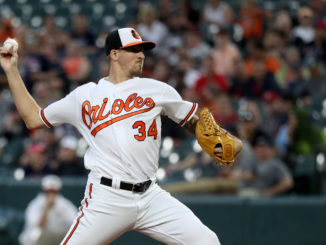
Leave a Reply